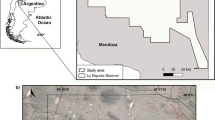Summary
Experimental reductions of productivity on feeding territories of Anna's hummingbirds (Calypte anna) decreased intrusion rate. This trend contrasts with the absence of strong correlations between intrusion rate and productivity in previous experimental studies. Consideration of sample sizes, productivity rates, and time-dependent influences on intrusion rate (e. g., day-to-day changes in weather) indicates that this difference resulted from the more natural spatial distribution of artificial flowers used in this study.
Similar content being viewed by others
References
Carpenter FL, MacMillen RE (1976) Threshold model of feeding territoriality and a test with an Hawaiian honeycreeper. Science 194:639–642
Ewald PW (1985) Influence of asymmetries in resource quality and age on aggression and dominance in black-chinned hummingbirds. Anim Behav 33:705–719
Ewald PW, Carpenter FL (1978) Territorial responses to energy manipulations in the Anna hummingbird. Oecologia 31:277–292
Ewald PW, Rohwer S (1980) Age, coloration and dominance in nonbreeding hummingbirds: a test of the asymmetry hypothesis. Behav Ecol Sociobiol 7:273–279
Ewald PW, Bransfield RJ (1987) Territory quality and territorial behavior in two sympatric species of hummingbirds. Behav Ecol Sociobiol 20:285–293
Gass CL, Montgomerie RD (1981) Hummingbird foraging behavior: decision-making and energy regulation. In: Kamil AC, Sargent TD (eds) Foraging behavior: ecological, ethological and psychological approaches. Garland STPM Press, New York, pp 159–194
Gill FB, Wolf LL (1975) Economics of feeding territoriality in the golden-winged sunbird. Ecology 56:333–345
Hixon MA, Carpenter FL, Paton DC (1983) Territory area, flower density, and time budgeting in hummingbirds: an experimental and theoretical analysis. Am Nat 122:366–391
McFarland DC (1986) Determinants of feeding territoriality in the New Holland honeyeater Phylidonyris novaehollandiae. Emu 86:180–185
Myers JP, Conners PG, Pitelka FA (1979) Territory size in wintering sanderlings: the effects of prey abundance and intruder density. Auk 96:551–561
Schoener TW (1983) Simple models of optimal feeding territory size: a reconciliation. Am Nat 121:608–629
Stiles FG (1973) Food supply and the annual cycle of the Anna hummingbird. Univ Calif Publ Zool 97:1–109
Tamm S (1985) Breeding territory quality and agonistic behavior: effects of energy availability and intruder pressure in hummingbirds. Behav Ecol Sociobiol 16:203–207
Author information
Authors and Affiliations
Additional information
Offprint requests to: P.W. Ewald
Rights and permissions
About this article
Cite this article
Marchesseault, L., Ewald, P.W. Effect of territory quality on intrusion rate in nonbreeding hummingbirds. Behav Ecol Sociobiol 28, 305–308 (1991). https://doi.org/10.1007/BF00164378
Received:
Accepted:
Issue Date:
DOI: https://doi.org/10.1007/BF00164378




